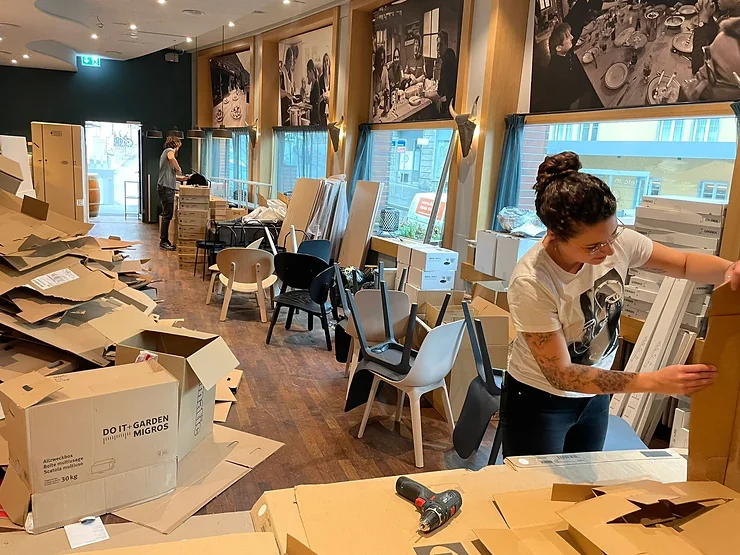The former Hotel Leoneck was transformed into a coliving house with 56 rooms, shared kitchens and coworking lounges in just 8 weeks. In just a short time, the previously vacant hotel was transformed to a place for community. Today, around 60 people live there, sharing not only kitchens and lounges, but also experiences and activities.
But how does a coliving community come into being? Here is a glimpse behind the scenes of its creation.

Finding A building
The first, most important step for a coliving community is finding a suitable building. TomoDomo is therefore always on the lookout for suitable properties to house communities. "In the fall of 2020, we contacted Stephanie Portmann, owner of Fred Tschanz AG to dicuss the idea of a hotel to coliving conversion," says Sandro Kummer, construction manager at TomoDomo.
In addition to a convincing concept, the economic viability of the project is crucial. "A coliving conversion must be financially viable for the property owner, otherwise a project succeed," says Johannes Peter, founder of TomoDomo.
Together with Fred Tschanz AG, the conditions were negotiated and the contract was in place at the beginning of 2021.
The conversation and its challenges
After the contract negotiations, the building permit was submitted to the city of Zurich. Permits from construction department, fire police, environmental agencies and others had to be obtained, which can pose its challenges. Structural analysis of the building structure was also essential, since several rooms were to be combined for the common areas and shared kitchens.
Obtaining such permits can take a long time, especially for a building from the 1930s. Getting all stakeholders involved early on and addressing issues right away help to keep things on track. In August 2021, construction finally started.
The goal: opening on October 1st. The construction period of 8 weeks was rather short: "Especially with an older building, there are always surprises," says Sandro Kummer, construction manager. "That's where you encounter horsehair insulation or Hourdis ceilings. Of course, such surprises were not included in the construction time."
When you have to keep an eye on profitability and time is running out, you get inventive. So the smoothing of the walls was turned into a team event without further ado. This team event was called "Smoothing and Grooving," and all team members and friends helped to make it work.
That's the big advantage in a startup and it's a lot of fun," says Andrea Frommenwiler, Marketing Manager.

How did the renovation proceed?
As befits an older building, a hazard materials analysis was carried out at the beginning to rule out harmful materials such as asbestos. Fortunately, this was negative.
After that, all the furnishings that were no longer needed were removed. The majority of them were given to charitable organizations or individuals.

This was followed by the removal of walls for the new common rooms. Two to three rooms were combined for the spacious kitchens.
In addition, all 56 rooms received a gentle renovation. Walls were painted and filled.
In the kitchens, the linoleum flooring was installed in a different color for each kitchen. Then followed the installation of the kitchens and the final painting work.

Design with individual history
The design concept is characterized by the 30s style. It takes up the history of the house built in 1935. For example, the new common rooms are decorated in pastel colors, which were often used in those days. Due to the shortage of raw materials, the colors were diluted with white paint at the time.
Johannes Peter comments: "Each of our houses is very individually designed. In the case of Domo Central, we wanted to respond to the building's period of origin and its proximity to central station in Zurich. The 'new' Central should offer an alternative to the anonymous city life."

Teamwork makes the dream work
Final installation of the kitchens, cleaning of the rooms and furnishing them, all had to happen in a very short time. To speed up the process the TomoDomo team also helped to assemble some of the furniture.
Two weeks before the opening, built-in stoves and countertops were still missing due to delivery delays. Replacement stove tops were installed so that the residents could still cook.
A week before the opening, the entire team was on site and lent a hand. Whether programming keys for the residents, attaching room numbers, washing bed covers or assembling and distributing the remaining furniture; everyone helped out where help was needed.
Thanks to the teamwork and a few night shifts, Domo Central was completed on time for the opening. It is unbelievable what is possible in a short time when everyone helps.

Cooperation and collaboration with the owner is key
To make this all work, a great colloaboration and communication with the owner is very important. "There is great collaboration with Fred Tschanz AG, which has its offices in the building. We have a close exchange, which made the planning and construction phase enormously easier," says Sandro Kummer.
What does the future hold?
And so around 60 people now live in the new Domo Central, sharing four large communal kitchens and other common rooms.
At the opening, the house was already completely booked out.
Demand for rooms for communities is constantly increasing. And so Domo Central will probably not be the last coliving house in Zurich.
